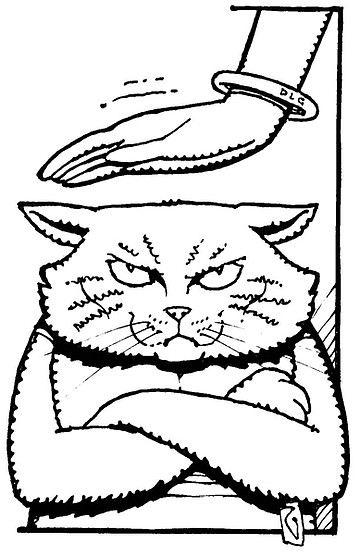 Facebook
Facebook
 X
X
 Instagram
Instagram
 TikTok
TikTok
 Youtube
Youtube

Hey Matt:
Why do cats purr? How do they do it, and why hasn’t my kitty ever done it? He’s five years old and I’ve never heard or felt him do it. He’s an affectionate, friendly, and well-adjusted boy. He just doesn’t purr. Does my feline simply not like to purr? Not a real big deal, I’m just curious.
— Vic and Reef, North Park

The Reefster might be purring, but you just can’t hear him. Happens often with cats, since purring measures at very low frequencies, between 25 and 150 Hz. Was he feral? Adoptees with hard lives sometimes take years to evolve into trusting purrers. Some cats purr only when a certain cat or person is present (or absent). And there are some perfectly acceptable cats who just never purr at all. Fully normal. Much is unknown about purring, though some wild cats do a form of it (wild cats that roar can’t purr, and vice versa). Purring is stimulated by repeated brain-wave signals that open and close vocal cords; breathing in and out makes the purr. It’s done when very content or under stress. Began as an involuntary response to nursing when the Reefster was but a kit.
Hey:
I first wrote to Matthew Alice in 1977 when I questioned him about the funny bone. I wrote to him just the other week questioning him about the terms moron, imbecile, and idiot. Did my question stump him so that he did not write his “Straight From The Hip” article?
— Allen Stanko, via email
Heymatt:
OK, I stumped you years ago, another go at it. When you look at the Google Maps aerial photos, you see helipads on the tops of tall buildings. I know why they are there, but I don’t know what the numbers painted inside the circles each helipad has mean. So, what do the numbers on the helipads indicate?
— Anonymous, Out There
Jeez, you guys have long memories. I prefer to look at the situation not as a failing but as consistency. I’m stumpable, and if I’m stumped I’ll ignore you. What could be clearer? But now I feel I need to scoop up these gauntlets, get them out of the driveway before Grandma comes after me, and throw around some facts.
And speaking of Grandma, queen of the mailroom, we sent her off to find Allen’s funnybone question from 1977. After ten minutes or so, she jetted out of the back room yelling something about a mass of startled wolf spiders and how they can run faster than she can and she’s not paid enough to deal with them. Okay. Instead we’ll make up a question for Allen about funnybones. Like, where did the funnybone get its name, since there’s not much funny about it. Maybe that was Allen’s 30-year-old question, maybe it wasn’t. And to show you what a good sport I am, I just offered up a question that I already know I don’t have an answer for! How’s that for honesty and humility? And consistency.
The word “funnybone” (aka, “crazybone”) appears in print in the 1840s, so it was probably in common speech before that. People who think they know the real origin of the term say it was a pun on the word “humerus,” the long bone of the upper arm. Your funnybone is actually a place in the elbow where the ulnar nerve is exposed and passes right over the end of the humerus. When it’s hit, you get that unpleasant tingling and pain. So, the word elites figure “funnybone” is linked to “humerus” via the homophone “humorous.” Weeeeell, for other wordists that’s too neat an explanation, one probably imagined well after the word appeared. They prefer the idea that the “funny” in funnybone (or “crazy” in crazybone) refers to the word’s original definition, strange or unusual. Hit your funnybone, you get a strange sensation. So we have two answers, which means we have no answers. Sorry, Allen. And the words idiot, imbecile, and moron long, long ago were formal psychiatric classifications for people of varying subnormal IQs. Because we’ve adopted those words willy-nilly into our common speech as insults, the psychs have moved on to other, less harsh classifications.
So, on to Anonymous’s helicopter mystery. I don’t recall ignoring this one, especially since I know the answer. Virtually all helipads on buildings are either for patient transport to hospitals or for emergency evacuations from tall buildings in case of fires or the like. The numbers are the maximum weight (in thousands of pounds, 8 equals 8000 pounds) the building can bear. If the numbers are inside a circle, it means the copters can land from any direction; into the wind is the preferred landing method. A triangle indicates that the landing must be made from a predetermined direction.


Hey Matt:
Why do cats purr? How do they do it, and why hasn’t my kitty ever done it? He’s five years old and I’ve never heard or felt him do it. He’s an affectionate, friendly, and well-adjusted boy. He just doesn’t purr. Does my feline simply not like to purr? Not a real big deal, I’m just curious.
— Vic and Reef, North Park

The Reefster might be purring, but you just can’t hear him. Happens often with cats, since purring measures at very low frequencies, between 25 and 150 Hz. Was he feral? Adoptees with hard lives sometimes take years to evolve into trusting purrers. Some cats purr only when a certain cat or person is present (or absent). And there are some perfectly acceptable cats who just never purr at all. Fully normal. Much is unknown about purring, though some wild cats do a form of it (wild cats that roar can’t purr, and vice versa). Purring is stimulated by repeated brain-wave signals that open and close vocal cords; breathing in and out makes the purr. It’s done when very content or under stress. Began as an involuntary response to nursing when the Reefster was but a kit.
Hey:
I first wrote to Matthew Alice in 1977 when I questioned him about the funny bone. I wrote to him just the other week questioning him about the terms moron, imbecile, and idiot. Did my question stump him so that he did not write his “Straight From The Hip” article?
— Allen Stanko, via email
Heymatt:
OK, I stumped you years ago, another go at it. When you look at the Google Maps aerial photos, you see helipads on the tops of tall buildings. I know why they are there, but I don’t know what the numbers painted inside the circles each helipad has mean. So, what do the numbers on the helipads indicate?
— Anonymous, Out There
Jeez, you guys have long memories. I prefer to look at the situation not as a failing but as consistency. I’m stumpable, and if I’m stumped I’ll ignore you. What could be clearer? But now I feel I need to scoop up these gauntlets, get them out of the driveway before Grandma comes after me, and throw around some facts.
And speaking of Grandma, queen of the mailroom, we sent her off to find Allen’s funnybone question from 1977. After ten minutes or so, she jetted out of the back room yelling something about a mass of startled wolf spiders and how they can run faster than she can and she’s not paid enough to deal with them. Okay. Instead we’ll make up a question for Allen about funnybones. Like, where did the funnybone get its name, since there’s not much funny about it. Maybe that was Allen’s 30-year-old question, maybe it wasn’t. And to show you what a good sport I am, I just offered up a question that I already know I don’t have an answer for! How’s that for honesty and humility? And consistency.
The word “funnybone” (aka, “crazybone”) appears in print in the 1840s, so it was probably in common speech before that. People who think they know the real origin of the term say it was a pun on the word “humerus,” the long bone of the upper arm. Your funnybone is actually a place in the elbow where the ulnar nerve is exposed and passes right over the end of the humerus. When it’s hit, you get that unpleasant tingling and pain. So, the word elites figure “funnybone” is linked to “humerus” via the homophone “humorous.” Weeeeell, for other wordists that’s too neat an explanation, one probably imagined well after the word appeared. They prefer the idea that the “funny” in funnybone (or “crazy” in crazybone) refers to the word’s original definition, strange or unusual. Hit your funnybone, you get a strange sensation. So we have two answers, which means we have no answers. Sorry, Allen. And the words idiot, imbecile, and moron long, long ago were formal psychiatric classifications for people of varying subnormal IQs. Because we’ve adopted those words willy-nilly into our common speech as insults, the psychs have moved on to other, less harsh classifications.
So, on to Anonymous’s helicopter mystery. I don’t recall ignoring this one, especially since I know the answer. Virtually all helipads on buildings are either for patient transport to hospitals or for emergency evacuations from tall buildings in case of fires or the like. The numbers are the maximum weight (in thousands of pounds, 8 equals 8000 pounds) the building can bear. If the numbers are inside a circle, it means the copters can land from any direction; into the wind is the preferred landing method. A triangle indicates that the landing must be made from a predetermined direction.
Comments